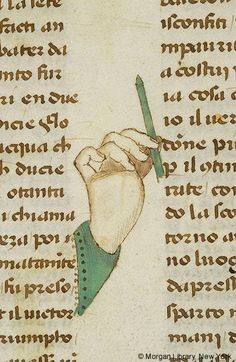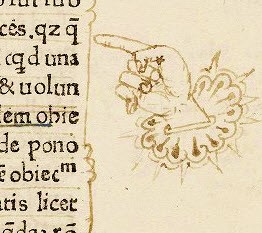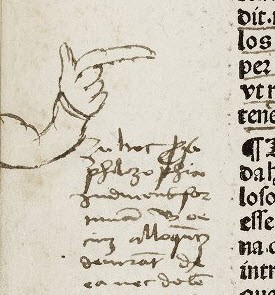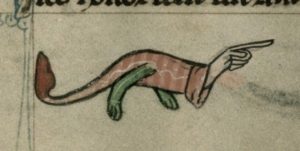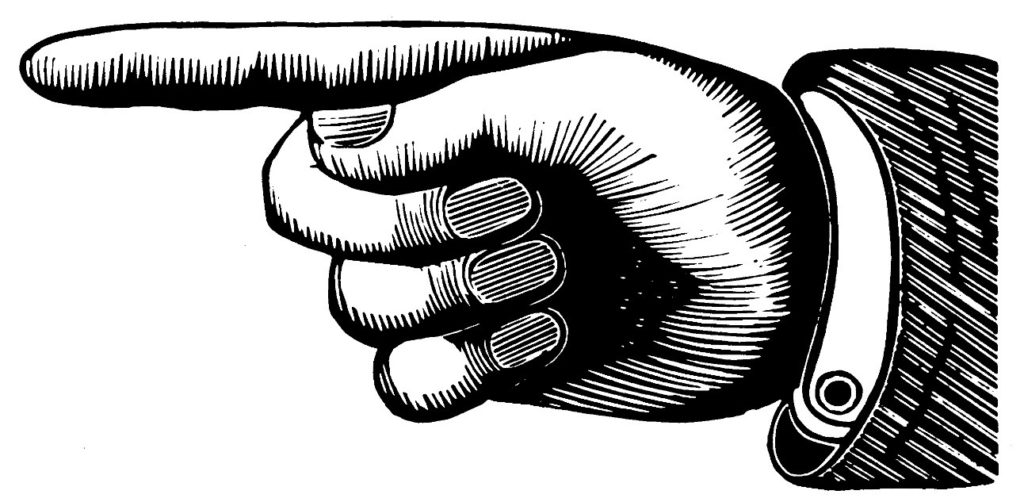The First Post It Note: The Manicule
Posted by Jane Metters LaBarbara.August 28th, 2017
Blog post by Stewart Plein, Rare Book Librarian
Throughout the history of the written word, whether it be a handwritten manuscript or the printed text, the reader’s need to mark a passage was always in demand. Before bookmarks, before post it notes, there was the manicule. Latin in origin, the root word manus, stands for “hand” and the word manicula for “little hand” or fist. Hence the word manicule represents a small hand, usually drawn with a finger pointing to the desired text.
The manicule shown above is elegantly drawn with delicate fingers grasping a writing implement, and a decorated green cuff finishing off the illustration. This design is by far more the exception than the rule. Most manicules are crudely drawn, examples of either the reader’s haste, or their drawing ability.
Manicules can be found in two volumes in WVU’s Rare Book Room. The first of these appears in a volume of medical botany from 1530, the Herbarum vivæ eicones ad nature imitationem: summa cum diligentia & artificio effigiatæ, una cum effectibus earundem, in gratiam ueteris illius, & iamiam renascentis herbariæ medicinæ. In this text a carefully drawn manicule with an extended index finger and a cuff points to the reader’s own commentary, written in the margin of the text.
The Rare Book Room’s copy of the Liber Chronicarum, more colloquially known as the Nuremberg Chronicle, was published in 1493 by Hartmann Schedel. The book chronicles the history of the world up to the year of publication from a biblical perspective. The reader has marked several passages with his own hastily drawn manicules, shown below. These manicules appear in the index. Note the text is in Latin and page numbers are printed in roman numerals.
Other manicules can be more detailed and inventive. Some manicules include a fancy cuff, fingernails, an enlarged index finger, or some decorative device that varies from the traditional fist or hand. Fanciful creatures are also known, such as the manicule headed fish and beast shown below.
The manicule moved from a hand-drawn mark to a form of printed punctuation in later years. The Victorians often used the pointing hand to direct the reader. Note the fingernail detail and the business suit shirt and cuff.
Stop by the West Virginia and Regional History Center or make an appointment to view these manicules first hand, as well as other medieval marginalia and annotations in the Rare Book Room.
Resources:
First image: https://www.pinterest.com/pin/527765650066747731/
Brunfels, Otto. Herbarum vivæ eicones ad nature imitationem: sum[m]a cum diligentia & artificio effigiatæ, una cum effectibus earundem, in gratiam ueteris illius, & iamiam renascentis herbariæ medicinæ. Argentorati: Apud Ioannem Schottum, 1530. Call number: QK41 .B78 1530. Image by Jessica Eichlin, West Virginia and Regional History Center
Schedel, Hartmann. Liber Chronicarum. Nuremberg, Germany: Anton Koberger, 23 Dec. 1493. Call number 909 Sch22l. Image by Jessica Eichlin, West Virginia and Regional History Center.
Manicule with cuff: https://wac.colostate.edu/atd/articles/horning2011/
Clawed beast manicule: https://www.buzzfeed.com/katewiles/x-manuscript-marginalia-that-look-like-emojis-lf86?utm_term=.caJRxQEVp#.myJYQKxv8
Fish manicule: https://www.pinterest.co.uk/pin/332914597435352337/
Victorian manicule: http://www.devilsartisan.ca/images/misc/manicule1.jpg






